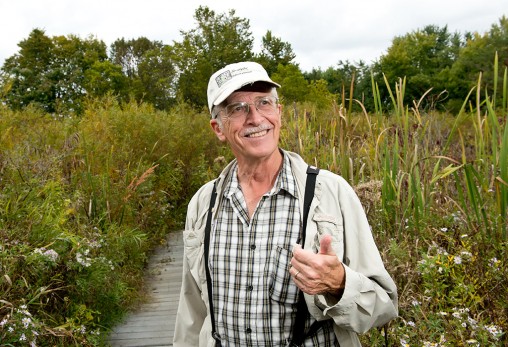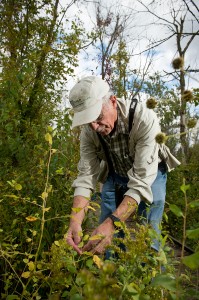
Jim Amon, a retired Wright State biology professor, has spent the past 25 years helping preserve and restore the Beaver Creek Wetlands near the Dayton Campus.
The boardwalk sponges down into marshy ground under the weight of the nature walkers. Cattails sway, woodpeckers peck, and colorful insects and plants paint the landscape.
Jim Amon is leading the way. The retired Wright State University biology professor has spent the past 25 years of his life helping preserve and restore the Beaver Creek Wetlands—2,000 acres of nature salad that is home to everything from the yellow warbler to the spotted turtle to the blue-leaved willow.
“By Yellowstone standards, it’s nothing; but in an urban area like this, it’s huge,” said Amon.
How huge?
Wetlands are rare, existing only in the right geologic settings. And nearly 90 percent of the wetlands that once freckled Ohio are gone, most of them drained so the land could be farmed.
“It’s something you just can’t find in a lot of other places in the world,” Amon said. “And I don’t think anybody else in the world has a resource like we do this close to a major educational institution.”
The 10-mile-long wetland is a five-minute drive from Wright State. Students use it for research projects and have served as volunteers to help in its restoration. One intern cleaned and planted seeds for 6,000 new wetland plants. Several students have set up stations to monitor water levels and water quality.
In September, the 70-year-old Amon was honored with a Lifetime Achievement Award by Partners for the Environment, whose mission is to protect, restore, preserve, and promote the resources of the Great Miami River and Miami River Watersheds in an 18-county region.
Amon led efforts to purchase wetland acreage and restore it; lobbied for state, federal, and local resources; and helped install boardwalks to make the wetlands accessible to the public. He also grew plants for replanting in the wetland and recruited students and other volunteers to control invasive plants, inventory bird populations, and install interpretive signage. Amon estimates he has attended hundreds of late-night zoning meetings over the past 25 years.
“Dr. Amon has devoted his time, expertise, energy, and continuous commitment to the wetlands,” said David Nolin, director of conservation for Five Rivers MetroParks.
Amon’s passion for nature sprang from growing up on a farm in southwest Ohio near Batavia, where he would hike all over the county and explore the woods.
“We had two creeks running through the property,” he recalled. “I would occasionally dam them up and make little wetlands and flood the road. My mom would say, ‘Get down here and clear out that dam.’”
Amon obtained his bachelor’s degree in biology from the University of Cincinnati and his master’s and Ph.D. in marine biology from William & Mary.
He served in the U.S. Army during the Vietnam War, stationed at the Dugway Proving Grounds in Utah from 1968 to 1970.
“I worked on biological warfare agents,” he said. “That gave me some experience in things like food-borne diseases.”
Amon arrived at Wright State in 1974 to teach marine biology. He later developed the microbiology and food microbiology courses. He is currently a retired professor, but still teaches a wetlands biology course and does some guest lectures.
Amon discovered the wetland shortly after he and his wife moved into the area from Virginia. Amon was thrilled. He had just finished working in the Chesapeake Bay wetlands, one of the largest in the world.
He became involved with preserving and restoring the Beaver Creek Wetlands in 1988 as part of a group of concerned citizens.
“These were people who weren’t just out on a lark; they were pretty serious about this,” Amon said. “They understood how important this wetland was and wanted to do whatever they could do to preserve it.”
With his scientific technical background, Amon helped lend credibility to what would become the Beaver Creek Wetlands Association, a group that counted among its members officials from the Ohio Department of Natural Resources, the Ohio Environmental Protection Agency, and the Nature Conservancy.
“One of the most gratifying things about working with the Beaver Creek Wetlands is working with people of a like mind who are as dedicated as they are,” Amon said.
Called the kidneys of the earth, wetlands filter and clean groundwater. For example, wetlands can turn what could be dangerous levels of nitrates from farm-runoff fertilizer into nitrogen that is harmlessly released into the air. As part of a research project, Amon created a wetland at nearby Wright-Patterson Air Force Base that eliminated solvents that had contaminated groundwater.
Wetlands also modify the surrounding air temperature, keeping it cooler in the summer and warmer in the winter. They also serve as nature preserves for wildlife and endangered plants.
“We have close to 500 species of plants out there; that’s like a tropical rain forest,” Amon said. “It’s so difficult to find anyplace that has that much diversity. Most of the things that are endangered that still exist are in wetlands because those are the last refuges.”
The largest wetlands in the world are the Amazon River basin and the west Siberian plain.
The Beaver Creek Wetlands is actually a fen, which is a wetland fed by groundwater. The groundwater at Beaver Creek flows through limestone, delivering minerals that keep the pH of the fen stable and enable it to help protect the purity of the underground aquifer.
To restore the wetland, Amon and volunteers installed some low dams, blocked drainage ditches, and blocked or removed terra cotta field drainage tiles, enabling the groundwater to rise to the surface.
The association also negotiated buffer zones between the wetlands and nearby housing developments. There is even a ban on lights that shine into the wetland.
In addition, it was decided to install boardwalks because it was difficult to wade into the wetland, and the waders were making paths that were taken over by invasive plants. So the association launched a fundraising campaign and bought materials for two boardwalks, the largest of which is about a mile long and loops back on itself through the tangle of plant life.
“We don’t want to love the wetland to death, but we need to get the public out to see it,” Amon said. “They have to be able to see what they preserved, and it’s worth seeing.”
An estimated 15,000 people use the boardwalk at the wheelchair-accessible Siebenthaler Fen, on Fairgrounds Roads in Beavercreek, each year.
Each May, the wetland hosts the Audubon Birdathon, a fundraising event in which participants attempt to identify as many species as possible. And in July, there is a butterfly watch. A few years ago, two Monarch butterflies tagged by the international monarch conservation project Monarch Watch were spotted in the wetland and their migration later tracked to Mexico.
“There is a lot of cool stuff going on,” Amon said.
Visit beavercreekwetlands.org to learn more about the Beaver Creek Wetlands Association.
This article originally appeared in the spring 2014 issue of the Wright State University Magazine.


 Wright State celebrates Student Success Champions
Wright State celebrates Student Success Champions  Wright State gold team captures 2024 Horizon League team title, Flynn individual champion
Wright State gold team captures 2024 Horizon League team title, Flynn individual champion  118 medical students to graduate from Wright State’s Boonshoft School of Medicine April 28
118 medical students to graduate from Wright State’s Boonshoft School of Medicine April 28  Wright State University continues to demonstrate its financial strength with another credit rating upgrade from Moody’s
Wright State University continues to demonstrate its financial strength with another credit rating upgrade from Moody’s  Thousands celebrate the end of Spring Semester with food, fun and friendship
Thousands celebrate the end of Spring Semester with food, fun and friendship 